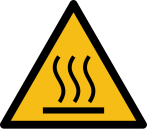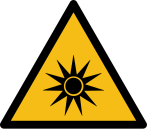[automatic translation]
Those who have to work outdoors or in workplaces at high temperatures are facing high risks in various ways. Especially in view of the heated earth’s atmosphere caused by the industrial climate catastrophe with increasing heat waves and droughts. The human body can cool itself during sweating due to evaporation cold, but only partially. However, a number of measures can help to strengthen health protection at work:
This includes a sufficient hydration with at least an hourly glass of cold water or unsweetened tea (e. g. mint or fruit). Small portions of light foods, such as fruit, salads or cold soups, are also recommended. However, alcohol, ice-cold lemonades, protein-rich food or a lot of coffee are not recommended. Dehydration quickly leads to fatigue, lack of attention and heat cramps, which also increases the risk of a work-related or commuting accident. In the long run, this lack of fluid leads to a dramatic loss of vital minerals, the electrolytes. These must then be supplemented as a soluble powder or by isotonic drinks. Fruit spritzer and salty broth are also useful as an alternative.
In case of emergency
If the blood vessels expand at high temperatures, there’sa risk of heat collapse. Signs are pale or dry reddened skin, fatigue, restlessness, dizziness, lightheadedness, headache, vomiting and cramps. Under no circumstances should the body temperature rise above 38°C for a long time, otherwise a life-threatening heat stroke can occur quickly: The brain swells and the nervous system is damaged permanently. Therefore, the affected person must be accompanied in the shade, placing damp cloths on the head, neck, arms and legs, as well as fanned fresh air. Call 112 in case of respiratory distress, mental confusion or fainting. If a cardiac arrest happens, perform cardiopulmonary resuscitation (CPR), maybe rescue breaths, until a paramedic arrives.
Preventive measures
In all companies, a healthy indoor climate is prescribed by the “Technical Rules for Workplaces” [in German: „Technische Regelungen für Arbeitsstätten (ASR)“] . Protection regulations also apply against high air temperature and humidity, as well as against ultraviolet radiation (UV light). The outside temperature in the shade should be measured hourly. Depending on the severity of the physical workload, the minimum temperature for working and social spaces is between +12°C and +20°C. If possible, these should not warm up above +26°C to avoid heat stroke. From +30°C, workplace measures against heat become mandatory, from +35°C these rooms are no longer suitable as workplaces.

Windows and skylights, as well as glass walls, should be covered by shadow from the outside as much as possible, so the rooms do not heat up excessively and sunlight does not dazzle. Use curtains, roller blinds, slats, nets, awnings, umbrellas, canopies and planting or protective foil. Buildings should cool down at night and ventilated in the morning. If possible, switch off all heat-emitting devices. Room temperature can be further reduced with fans, blowers or air conditioning.
However, ventilation systems must not be too noisy and draught must not put undue strain on people. Regular, short shock ventilation should take about 10 minutes, depending on the outside temperature and wind. Supplied air must of course be oxygen-rich and free from smoke, exhaust fumes, nitrogen oxides, smog or allergenic pollen.
The Corona respiratory protection still must be taken into account, while the SARS-CoV2 virus continues to be a major health threat!
If possible, a long lunch break (“siesta”) is recommended. A flexible working-time arrangement to shift activities to cooler periods of the day, such as morning or evening hours, might help. Ifpossible, relocate workplaces to cool basements.
If the temperature exceeds +35°C, heavy physical work should be avoided. If it’s unavoidable, then increase work gradually and plan shorter deployments, interrupted by cooling phases. That’s also advised when working on open flames, cooking pots, pans and ovens, or near heat-emitting machines and engines.
If work clothesare required despite heat stress conditions, tryloose garment (e. g. short-sleeved tops, shorts or skirts). The fabrics should be breathable and easy to wear. However, if Personal Protective Equipment (PPE) has to be worn – especially during a pandemic – the body might fail to cool itself. As a result, heat accumulationcould cause cardiovascular risks.
Hats, caps, hoods, headscarves and sunsreen protect against carcinogenic sunlight, which also weakens the immune system. In addition, sunglasses and opaque, light-coloredgarment protects against direct and indirect UV radiation.
Heat protective clothing, cooling vests, misting or air showers provide additional chilling effects. Footbath and arm baths also provide relief, as well as waterspraywater and cooling lotions. Above +30°C, the company must provide free, appropriate beverages (e. g. tap water) for employees.
Especially chronically ill patients and disabled, elderly or under/overweight persons are at high risk, as well as pregnant women. Working in vehicles and cabins or in a standing position is also an increased risk. During rest periods take cool or lukewarm showers, cold baths, wet sheet or gel packs and sufficient sleep can reduce harmful efects.
Evaporative air conditioning, swamp coolers or wet sheets are common, but the relative indoor humidity must not create a moist climate, which leads to additional health risks. Therefore, at +26°C there should be a maximum humidity of 55%, whereas above +35°C this “sultryness limit” equates 33%. Unfortunately, these regulations do not apply to kitchens and greenhouses. However, high humidity also increases the exposure to mould and bacteria, as well as the risk of contactless electric shock due to higher conductivity of the air.

Because ofhigh temperatures and blazing sunshine, you should avoid hot surfaces, as well as handling and storing flammable or hazardous substances. Attention must also be paid to the risks of fire and exploding gases, varnishes, fuel, disinfectants and solvents. During heat and drought it’s also important to prevent bush or forest fires. In addition, there’s an increased risk of carbon dioxide exposure in enclosed spaces, cellars or construction sites. All work in poorly ventilated or airtight enviroments must be considered as risks in a hazard assessment, while appropriate precautions must be taken to provide workers with oxygen.
In offices you should keep distance to photocopiers and laser printers, not only because of particulate matter from air polluting toner, but also due to ozone emissions. Outdoors on ground-level, UV radiation causes high concentrations of this gas, which irritates eyes and mucous membranes, as well as respiratory problems – even in the shade.
When it’s hot and sunny, it’s best to take a lot of breaks, but don’t work overtime!
Inform all colleagues, pay attention to each other and organise yourselves!
Because only together, we can fight the consequences of the industrial climate catastrophe!
Anarcho-Syndicalist Network – ASN Cologne,